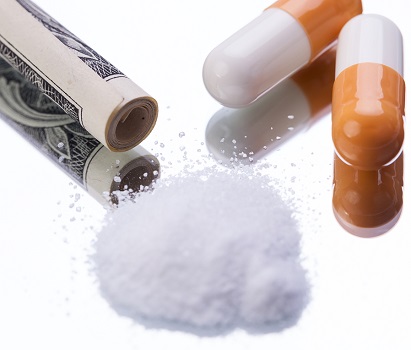Death rates due to fentanyl overdose continue to rise exponentially each year. What exactly is fentanyl and how has it founds its way into the pockets of heroin users nationwide? 582 overdose deaths were linked to fentanyl in 2014. That number skyrocketed to 3,946 in 2016, multiplying by nearly seven times in the course of two years. We also just lost another performer to a Fentanyl overdose this month: Dolores O’Riordan from the Cranberries. Clearly, fentanyl is one of the most dangerous opioids and it has found its way onto the streets and into the supplies of addicts nationwide. The Centers for Disease Control and Prevention report fentanyl as being 50 to 100 times more potent than morphine and heroin. This means a lethal dose of fentanyl is much, much smaller than a lethal dose of heroin. Opioid overdose rates are multiplying exponentially every year because heroin is now being laced with the synthetic opioid. “If anything can be likened to a weapon of mass destruction in what it can do to a community, it’s fentanyl,” stated Michael Ferguson. Ferguson is the Drug Enforcement Administration’s agent in charge of the New England area, where the drug is overwhelmingly present. Since no addict carries around a testing kit to check the contents of their drugs before using them, they never know whether or not this dose will be their last. If their latest pickup contains trace amounts of fentanyl, it could easily be the final time they ever get high. What exactly is fentanyl? How is it made? And how has it made its way onto city streets and into the systems of heroin addicts under the guise of a “less harmful” opiate? Read on to learn more about fentanyl and its impact on communities across the United States.
What is Fentanyl?
Fentanyl is a pharmaceutical drug, a synthetic opioid pain reliever similar to morphine and Dilaudid. It is easily one of the strongest pain relievers available and usually prescribed in the form of fentanyl patches, oral sprays, or lozenges. You must have a prescription in order to purchase it from the pharmacy. Additionally, fentanyl is a Schedule II drug under the Controlled Substance Act. This means that only those with a valid prescription from a doctor can possess and ingest it. There are a few different brand names of the drug, including:
- Duragesic – transdermal patch (patch placed on the skin)
- Subsys – sublingual spray (sprayed underneath the tongue)
- Abstral – sublingual tablets (placed beneath the tongue)
- Ionsys – transdermal system delivery pack (pack attached to the skin that administers doses)
It is mostly used to treat chronic pain in those with late-stage cancer. The onset of Duragesic, Subsys, Abstral, and Ionsys are almost immediate; effects of these drugs are felt as quickly as five minutes after delivery. It comes on strong and lasts for a few hours depending on dose size and tolerance. The risk for addiction to fentanyl is off the charts; for this reason, its use is often limited to hospital environments where doctors can oversee use and delivery. For example, Ionsys packs are not permitted for use outside of the care of doctors in the hospital.
Effects of Fentanyl: What is the High Like?
Again, drugs containing fentanyl are synthetic opioids. They interact with the same receptors as regular prescription pain killers and hard opiates like heroin. Because of this, they provide a high similar to that of pain killers and heroin but are much stronger. Fentanyl effects come on sudden and strong. How do you get high on a fentanyl patch? Many times, people will take Duragesic patches and chew them as opposed to placing them on their skin. By ingesting the medication orally, the effects take hold much quicker. Fentanyl’s attachment to the brain’s opioid receptors results in a relaxed state of mind and a state of euphoria. Users often chase after this initial calm euphoria they experience but are often never able to achieve the same feeling as the first time they got high. This results in a cyclical loop of getting high, not achieving the high they want, then taking more which increases their tolerance and decreases the drug’s effects. And because of its extreme potency, chasing a fentanyl high can be a dangerously lethal game.
Side Effects of Duragesic, Astral, Ionsys, and Subsys
Like all medications, fentanyl-based prescriptions come with their own set of side effects. As they are another type of synthetic opioid, the side effects of fentanyl are similar to other prescription pain killers. These include:
- Intense euphoria
- Drowsiness
- Dry mouth
- Lightheadedness
- Difficulties urinating
- Severe constipation
- Respiratory difficulties
- Weakness and fatigue
The intensity of these fentanyl side effects depends on the type of medication used, the amount used, and the frequency at which the user takes it.
Why Is Fentanyl Stronger Than Heroin?
The chemical structure of fentanyl causes its heightened potency in comparison to heroin. While both substances bind to the mu opioid receptors in the brain, Astral and other fentanyl-based medications reach these receptors quicker than heroin does. Additionally, it binds itself to the receptors much tighter than does morphine, the active ingredient in heroin. Because of this, the onset is much quicker and oftentimes the user’s reaction to life-saving medications like naloxone are limited. Higher doses of naloxone are needed to save those experiencing a fentanyl overdose. As the drug attaches so closely to the receptors, it takes a greater amount of Narcan to detach these chemicals from the brain. Saving someone from an overdose is still possible but it is important to remember that a higher dose of naloxone is likely necessary to do so.
How Does the Pain Reliever Make Its Way into the Streets?
While Duragesic, Subsys, Abstral, and Ionsys are available on a prescription basis, fentanyl is widely available from drug dealers in the streets. Usually laced into heroin, the fentanyl found in the streets is often manufactured illegally. Rather than acquiring it from a doctor, dealers create their own synthetic opioid to cut into the heroin they sell. It solidified its place in the world of opiates in roughly the 1990s as increasing numbers of people turned to heroin as an alternative in the emerging world of prescription pain killers. Heroin users quickly developed a tolerance and dealers looked for ways to increase the potency of their supply while keeping costs low. Synthetic fentanyl, produced in labs at home, was the solution to their question. This artificial street version of Abstral and Ionsys has hardly any consistency, making it even more dangerous to use. It is already lethal in small doses to begin with; add in the inconsistency between batches and users have a recipe for fatal disaster on their hands.
Signs of a Fentanyl Overdose
Witnessing a fentanyl overdose can be a terrifying thing. For those who use Duragesic, Subsys, or Abstral at home, or who use heroin that is potentially laced with the drug, knowing what to look for is absolutely necessary. What does a fentanyl overdose look like? One side effect of prescription opioids is labored breathing or respiratory difficulties. To be specific, opioids slow down the user’s breathing. An overdose occurs when a user takes too much of a drug for their body to handle at one time and they stop breathing entirely. This cuts off the supply of oxygen to their brain which, if not addressed immediately, can lead to permanent brain damage or death. Signs of overdose include:
- Difficulties breathing
- Slowed heart rate
- Confusion
- Dizziness
- Difficulties thinking, speaking, or walking
- Pale face
- Blue-colored lips or fingernails
- Vomiting
- Nodding off (fainting spells)
- Passing out
- Seizures
- Unresponsiveness
- Coma
- Respiratory arrest
- Death
Treatment for an overdose should begin as soon as the signs are recognized. The longer the user’s brain is cut off from oxygen, the greater their chances of permanent brain damage or death. Again, the chemical composure of fentanyl makes it somewhat resistant to the effects of opioid overdose reversal drugs like Naloxone. Still, having the overdose antidote on hand can increase the likelihood of their survival.
Fentanyl Dependence vs. Fentanyl Addiction
Cancer patients who rely on Subsys or Ionsys for their pain relief quickly and easily develop a dependence on fentanyl. However, this does not necessarily indicate addiction. A line exists between dependence and addiction with one significant difference: compulsive use. Those with a dependence on a drug rely upon it in order to function. While they can live without it, their quality of life is much higher when they are able to use it. On the other hand, addicts find themselves using compulsively with little thought put into the action. They will get high whether or not they need to and oftentimes continue to get high despite the mounting consequences that come as a direct result of their use. The similarity between those with fentanyl dependence and fentanyl addiction are the withdrawal symptoms. Whether you’re dependent or addicted, you will experience withdrawal symptoms upon separating from the drug. When used under the supervision of medical professionals, if they decide to remove fentanyl from your treatment regimen, they will taper you off at a comfortable pace. If you use a synthetic street version of it or find yourself chewing Duragesic patches without a doctor’s input, the withdrawal symptoms will be much harder to manage.
Withdrawing from Duragesic, Subsys, Astral, or Ionsys
It is possible to quit using fentanyl-based drugs like Subsys, Duragesic, Astral, or Ionsys, but it will not be without some discomfort. Since these drugs directly impact your body’s perception of pain, the withdrawal process is often at least somewhat painful. Your body becomes used to the input of these pain-relieving medications and its tolerance for pain becomes much lower without them. The effects of the fentanyl withdrawal process include:
- Excessive yawning
- Extreme exhaustion
- Profuse sweating
- Restlessness
- Tearing up (excessive tear production)
- Runny nose
- Chills
- Back aches
- Stomach cramps
- Pain or aches in joints and muscles
- Muscle weakness
- Nausea
- Vomiting
- Lack of appetite
- Diarrhea
- Increased heart rate
- Increased respiratory rate
- Insomnia
- Increased anxiety and frustration
There are a number of psychological side effects during the opioid withdrawal process as well. Addiction has an incredible psychological impact from cravings to the depression following getting clean and sober. The brain adapts to the induced state of euphoria and when the substance that causes that is removed, there seems to be little pleasure left in life.
Fentanyl Addiction is Not the End of the Road
There is good news: it is possible to get clean and live a life free of fentanyl! With the help of addiction treatment, addicts can wean off of fentanyl and escape the bondage of the life-altering drug. Although it takes time and dedication, recovering from fentanyl addiction is one of the most rewarding experiences. Give yourself the chance to be free. Your life is worth it!







